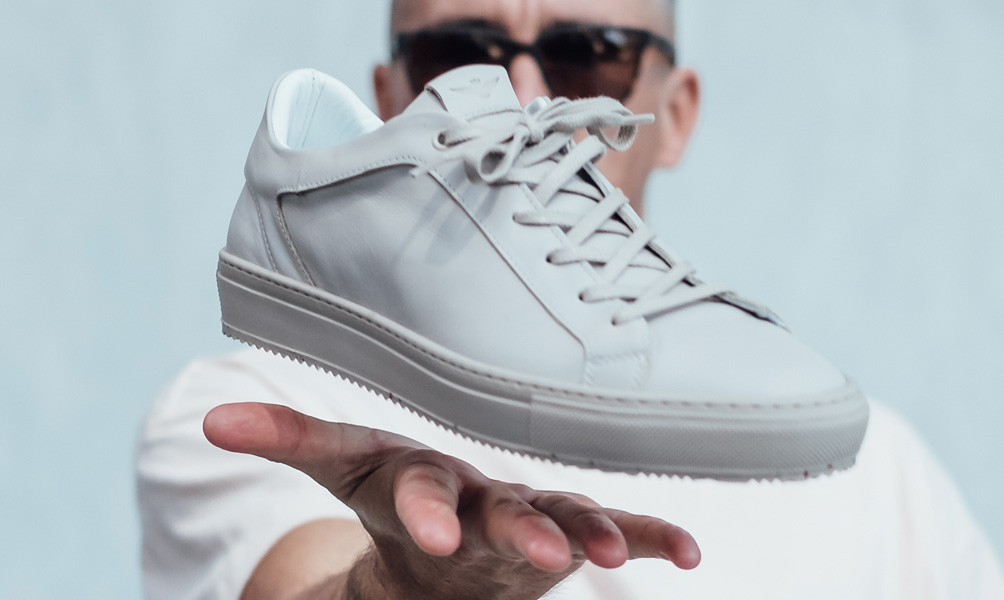04 Jun 2021
What are eco-friendly sneakers and how are they made?
Unless you’ve been living under a plastic rock the past few years, you’ll know that fast fashion is kind of problematic. Around 20 billion pairs of shoes are manufactured every single year, and roughly 300million of those end up in landfill. Some rubber soles can even last 1000 years before they start breaking down. Not great, right? This is why the world needs sustainable sneakers.
As part of the fashion industry, and as a company that makes a tonne of shoes, we’re doing everything we can to make our Aquila products more ethical and eco-friendly. Starting with the Tracer.
The problem with sneakers
Most sneakers are made from a combination of leathers, synthetics, rubber foam and plastic. This causes two big problems. First, a lot of that stuff isn’t biodegradable, and it’s quite energy-intensive to manufacture. Second, sneaker trends change so rapidly that consumers are encouraged to ditch their old shoes as soon as possible and run out to buy new ones. But it’s not all doom and gloom. Investing in some sustainable leather sneakers, and looking after them properly, is a great way to reduce your environmental footprint (literally).
Slow Fashion
You’ve heard of fast-fashion, but have you heard of its opposite – ‘slow fashion’? Rather than scrambling to the latest fad trend on the fast-fashion market, slow fashion promotes choosing better quality products that will last longer, with an awareness of production processes, resources and environmental benefits in the decision making process. Take a timeless style like a black derby lace up. Rather than opting for synthetic style that may be a cheaper alternative now, but will mean you need to replace them often in the future, why not choose a leather option that will last you for years to some? Purchasing a better quality shoe now means less environmental impact during the production process, as well as meaning a reduction in landfill.
Leather and the Environment
When it comes to choosing the best materials for the environment, leather has some really great qualities. Leather is a natural product, meaning it is biodegradable at the end of its life. The leather used in fashion is actually a bi-product of the food industry, meaning it would end up in landfill if not repurposed in the fashion industry. It is durable and long-lasting, meaning it can stay in your wardrobe for years on end if looked after properly.
What’s the Tracer?
The Tracer is Aquila’s new ethical sneaker. It’s a low-top sneaker with a full leather upper and an outsole made from 70% recycled materials. We’ve got them in cream, blue, white and black. The Tracer is part of our Better Soles Project—Aquila’s commitment to reduce waste in our supply chain, use more sustainable materials, slim down our packaging, and generally be a better shoe company.
How do you make them?
Tracers are exciting because they’re the first Aquila sneaker to use pre-consumer offcuts. Basically, when you make a shoe, you’re left with bits of spare rubber and all sorts of scrap material. Instead of chucking that stuff out, we’ve recycled 70% into the outsoles of the Tracer. This is good news, because recycling offcuts uses less energy and produces less waste than making the soles from scratch. And obviously it keeps all that rubber out of landfill. Win/win.
What to look for with eco-friendly sneakers?
Terms like ‘eco-friendly’ and ‘sustainable’ are a bit of a sliding scale, so you need to do your research when it comes to buying sneakers that are good for the environment. Ideally, you’re looking for good quality materials, a considered production process, and sustainable packaging. Our Boston Desert Boot soles, for example, are made from a 100% leather upper and lining, as well as 10% cork and 90% recycled material sole.
What’s the Better Soles Project?
The Better Soles Project is Aquila’s ongoing commitment to be more responsible with our shoes. That means using more and more recycled materials, cutting down on excess packaging, monitoring our supply chains, and communicating all this stuff to you guys. We’ve already made some big strides, reducing single-use plastic in our packaging by 90% and switching to more eco-friendly processes, like Incas Vegetable Tanning. But it’s always an ongoing journey. There are dozens of ways to get better.

.png.png?timestamp=2025-11-05T00:00:00+00:00)
